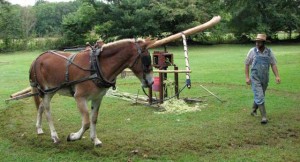There is a popular photograph of the Gregg-Cable house in Cades Cove taken from across a field of the house, showing it at an angle, the fence that surrounded it, as well as a few landmarks that stood outside the property. One of those landmarks is a Sorghum Mill – a very important piece in the history of Cades Cove.
 For sweetener in food and drink, Great Smoky Mountain settlers used such home-made products as maple syrup, honey and maple sugar. They also used a dark, sweet syrup called molasses. Added to biscuits or corn bread with a little butter and you had a mountain delicacy that hard to beat.
For sweetener in food and drink, Great Smoky Mountain settlers used such home-made products as maple syrup, honey and maple sugar. They also used a dark, sweet syrup called molasses. Added to biscuits or corn bread with a little butter and you had a mountain delicacy that hard to beat.
In Cades Cove, molasses was made by way of a sorghum mill like the one found near the Gregg-Cable house. From its beginnings as sorghum cane, Molasses are produced by stripping the leaves off the sorghum cane, then feeding them between the rollers of the sorghum mill.
A mule, horse, or an ox would walk in circles, attached by a harness to the long poles of the mill. This continuous walking would keep the rollers turning which pulled the stalks further into the mill where the sorghum juice was squeezed out of the stalks. The juice was then collected and subsequently boiled down in an outdoor furnace until it was thick and dark. Molasses could be used as a sweetener in a variety of ways. Molasses can be purchased about the middle of September into October at the Cades Cove visitors center.
The sorghum mill is an interesting contrast to the Cable Mill. The farmer had two energy sources: water power and animal power. One was strong but stationary; the other portable but relatively weak. Both served well into this century on mountain farms.